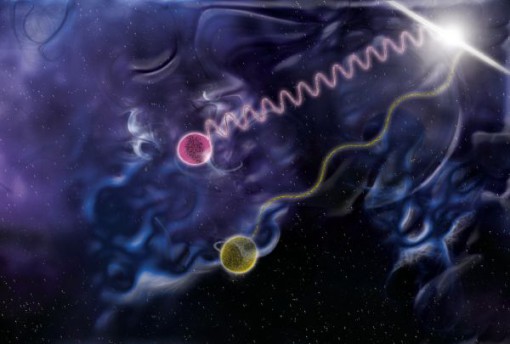 Researchers of the National Institute of Optics of the Florence CNR and of the European Laboratory of Nonlinear Spectroscopy of Florence University, in collaboration with the University of Seoul, in Korea, and of Queensland, in Australia, have obtained in laboratory a hybrid light state where two light pulses are inextricably linked. Actually, for the first time they have experimentally demonstrated the possibility of a light state where a photon is both present and absent, in addition to the fact that a weak laser pulse has two opposite phases simultaneously. Quantum mechanics does not forbid such possibilities, even if paradoxical, in a macroscopic physical system, and concerning this in the Thirties the Austrian scientist Schrödinger proposed, even if with a certain bad taste, a logical paradox: a cat is closed inside an airtight container together with a radioactive atom and a vial of poison and, with a 50% probability, the atom might disintegrate, releasing a radioactive particle that breaks the vial, thus killing the cat. However, according to the quantum physics rules, the atom might also be in an intermediate situation, in which it is simultaneously disintegrated and not, the poison vial is both broken and integer and the cat in a strange suspended state, dead and alive at the same time. Researchers state they managed to prove the production of a so-called “entangled” light state, hybrid between classic and quantum, optical equivalent of the “intertwined” condition of the “quantum” atom and of the ‘”classic” cat in the box, with the atom role supported by a single photon and the cat’s role by a weak pulse of laser light. If the photon is present, the laser light has a determinate phase, while if it is absent it has the opposite phase, with exchange of the peaks and of the valleys of the oscillation of its electromagnetic field. Like in the paradox of the cat, until the box is opened, that is to say until when is executed a measuring that actually imposes to the system of deciding its state, both alternatives together are true: the photon is both present and absent and, correspondingly, the weak light pulse has two opposite phases, in an analogous state to the one imagined by Schrödinger. More practically, and here resides the importance of the research, the first implementation of such a particular light state will allow developing essential components like repeaters, memories and interfaces, for a future communication net and for a new generation of quantum computers.
Researchers of the National Institute of Optics of the Florence CNR and of the European Laboratory of Nonlinear Spectroscopy of Florence University, in collaboration with the University of Seoul, in Korea, and of Queensland, in Australia, have obtained in laboratory a hybrid light state where two light pulses are inextricably linked. Actually, for the first time they have experimentally demonstrated the possibility of a light state where a photon is both present and absent, in addition to the fact that a weak laser pulse has two opposite phases simultaneously. Quantum mechanics does not forbid such possibilities, even if paradoxical, in a macroscopic physical system, and concerning this in the Thirties the Austrian scientist Schrödinger proposed, even if with a certain bad taste, a logical paradox: a cat is closed inside an airtight container together with a radioactive atom and a vial of poison and, with a 50% probability, the atom might disintegrate, releasing a radioactive particle that breaks the vial, thus killing the cat. However, according to the quantum physics rules, the atom might also be in an intermediate situation, in which it is simultaneously disintegrated and not, the poison vial is both broken and integer and the cat in a strange suspended state, dead and alive at the same time. Researchers state they managed to prove the production of a so-called “entangled” light state, hybrid between classic and quantum, optical equivalent of the “intertwined” condition of the “quantum” atom and of the ‘”classic” cat in the box, with the atom role supported by a single photon and the cat’s role by a weak pulse of laser light. If the photon is present, the laser light has a determinate phase, while if it is absent it has the opposite phase, with exchange of the peaks and of the valleys of the oscillation of its electromagnetic field. Like in the paradox of the cat, until the box is opened, that is to say until when is executed a measuring that actually imposes to the system of deciding its state, both alternatives together are true: the photon is both present and absent and, correspondingly, the weak light pulse has two opposite phases, in an analogous state to the one imagined by Schrödinger. More practically, and here resides the importance of the research, the first implementation of such a particular light state will allow developing essential components like repeaters, memories and interfaces, for a future communication net and for a new generation of quantum computers.
Wire Tech World © 2025 All Rights Reserved



